Bluetooth® LE Audio Solutions
Contents
- Introduction
- Resources
- Bluetooth® LE Audio
- B91 Unicast Audio Development Kit List
- B91 Broadcast Audio Development Kit List
- Purchase
Introduction
By using less power and less bandwidth yet still enabling high-quality audio transmissions, LE Audio is undoubtedly an improvement on Bluetooth Classic and Bluetooth LE. It opens up many new opportunities for audio device manufacturers, especially with the right SoC solution. Telink’s multiprotocol TLSR9 chip is in compliance with not only the Bluetooth LE standard but also EDR, BR, and LE, and can provide all of the aforementioned LE audio applications. Telink offers ready-to-use development kit for immediate evaluation.
Resources
| Part Number | SDK Files | Reference Design | Document |
|---|---|---|---|
| TLSR951x | Please Contact Telink Sales Team | B91 Unicast Audio Kit B91 Broadcast Audio Kit |
User Guide(EN) User Guide(CN) |
Bluetooth® LE Audio
Bluetooth LE 5.2 Enables New Audio Use Cases
- Two types of ISO transfers defined in Bluetooth 5.2
- Connection-oriented: logical transport referred as Connected Isochronous Stream (CIS)
- Connection-less: logical transport referred as Broadcast Isochronous Stream (BIS)
- ISO Data channel allows transfer of isochronous data between a Bluetooth LE central and one or more Bluetooth LE peripherals
- Used for new application area for audio streaming and audio broadcasting
- Can also be used for non-audio time-bounded data
- Introduce a new high-quality, low-power LC3 audio codec
B91 Unicast Audio Development Kit List
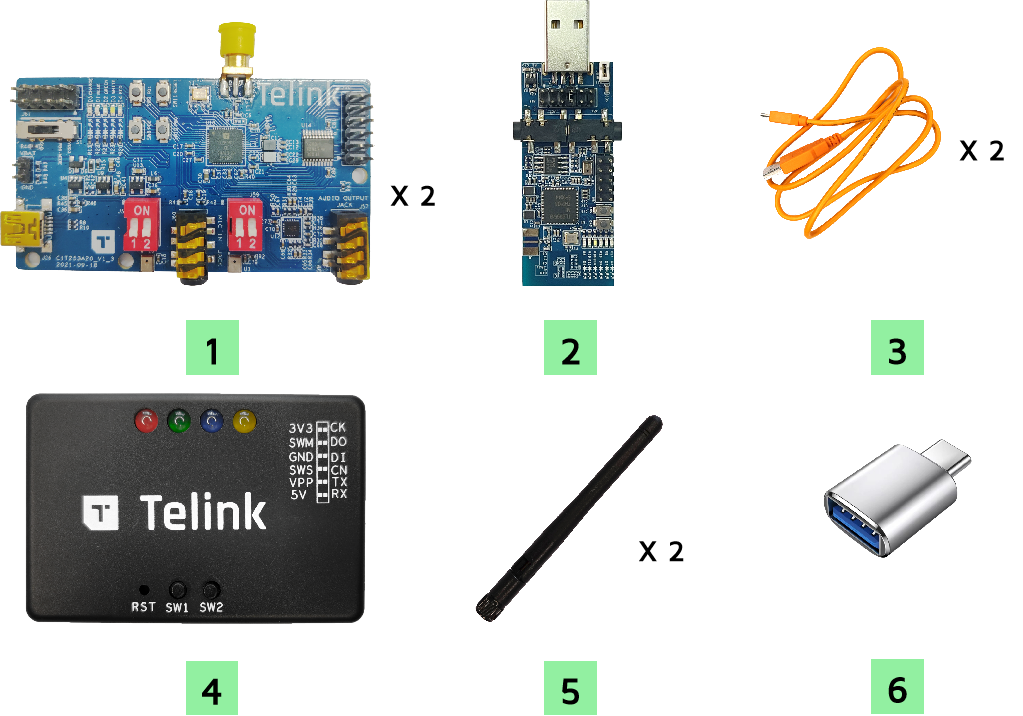
| Item | S/N | Product Name | Qty | Description |
|---|---|---|---|---|
| 1 | TLSR9517CDK56D | B91 Audio Development Board | 2 | including jumpers |
| 2 | TLSR9518ADG80D | B91 Dongle | 1 | |
| 3 | USB cable | 1 | USB A to mini USB | |
| 4 | TLSRGSOCBK56B | Telink Burning Board | 1 | including DuPont wires |
| 5 | Whip Antenna | 2 | 2.4Ghz antenna | |
| 6 | USB Convertor | 1 |
Unicast Demo Scenario 1
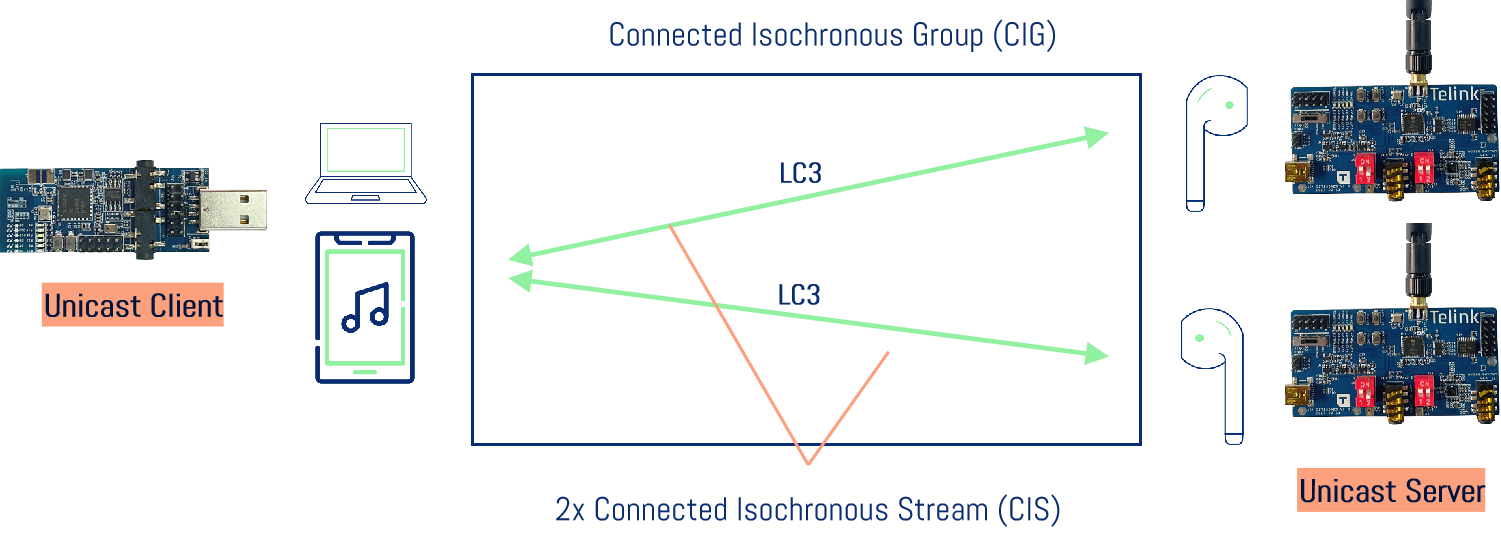
One unicast client to two unicast servers, with an uplink dual channel 16kHz sampling rate and a downlink dual channel 48kHz sampling rate, simulating TWS scenario as shown the above.
Step 1: Burn the unicast client firmware into a B91 dongle and connect it to the phone/PC via USB.
Step 2: Burn the unicast server firmware into two B91 audio development boards (select left and right ear respectively), and power them via USB.
Step 3: Press SW2 button on the dongle to pair, the dongle connects to one unicast server device, then it will automatically search and connect to another unicast server via the coordinated set CSIP protocol.
Step 4: Play music or open the recording on the phone/PC to test the audio uplink and downlink channel.
Unicast Demo Scenario 2
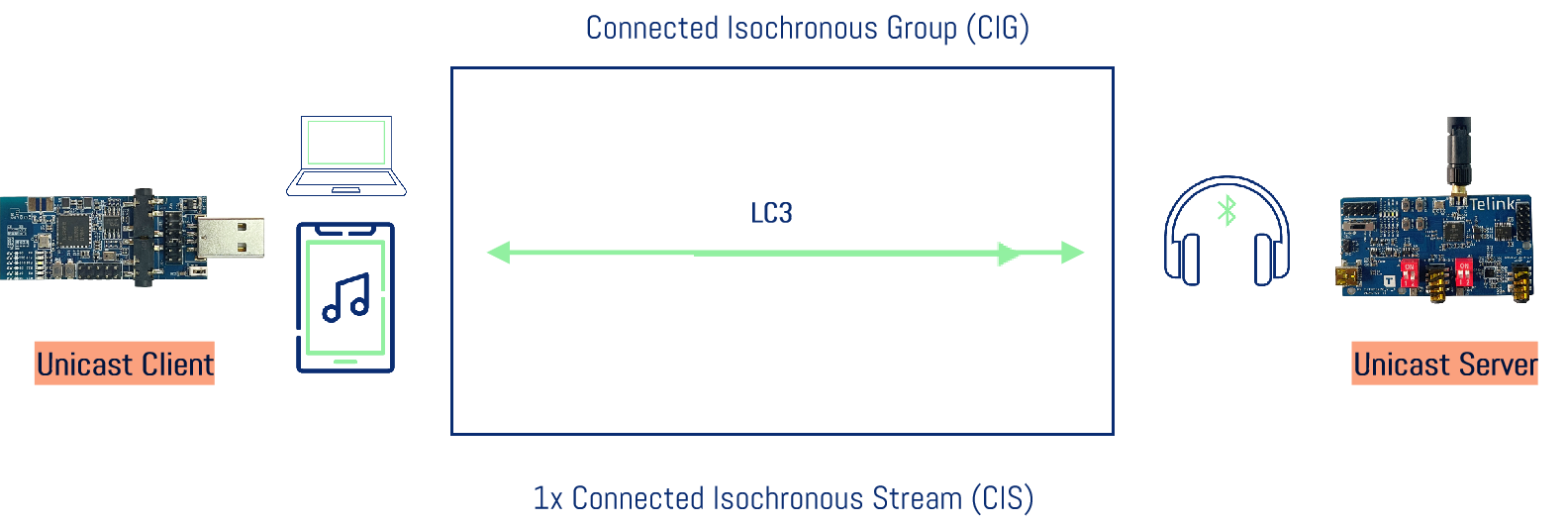
One unicast client to one unicast server, with a downlink 48kHz dual channel and multiplexing technology.One CIS channel transmits two audio data channels, and uplink 16kHz mono channel, simulating headset scenario, as shown above.
Step 1: Burn the unicast client firmware into one B91 dongle and connect it to the phone/PC via USB.
Step 2: Burn unicast server firmware into one B91 audio development board, and power it via USB.
Step 3: Press SW2 button on the dongle to pair, and the dongle connects to the target unicast server.
Step 4: Play music or open the recording on the phone/PC to test the audio uplink and downlink channel.
B91 Broadcast Audio Development Kit List
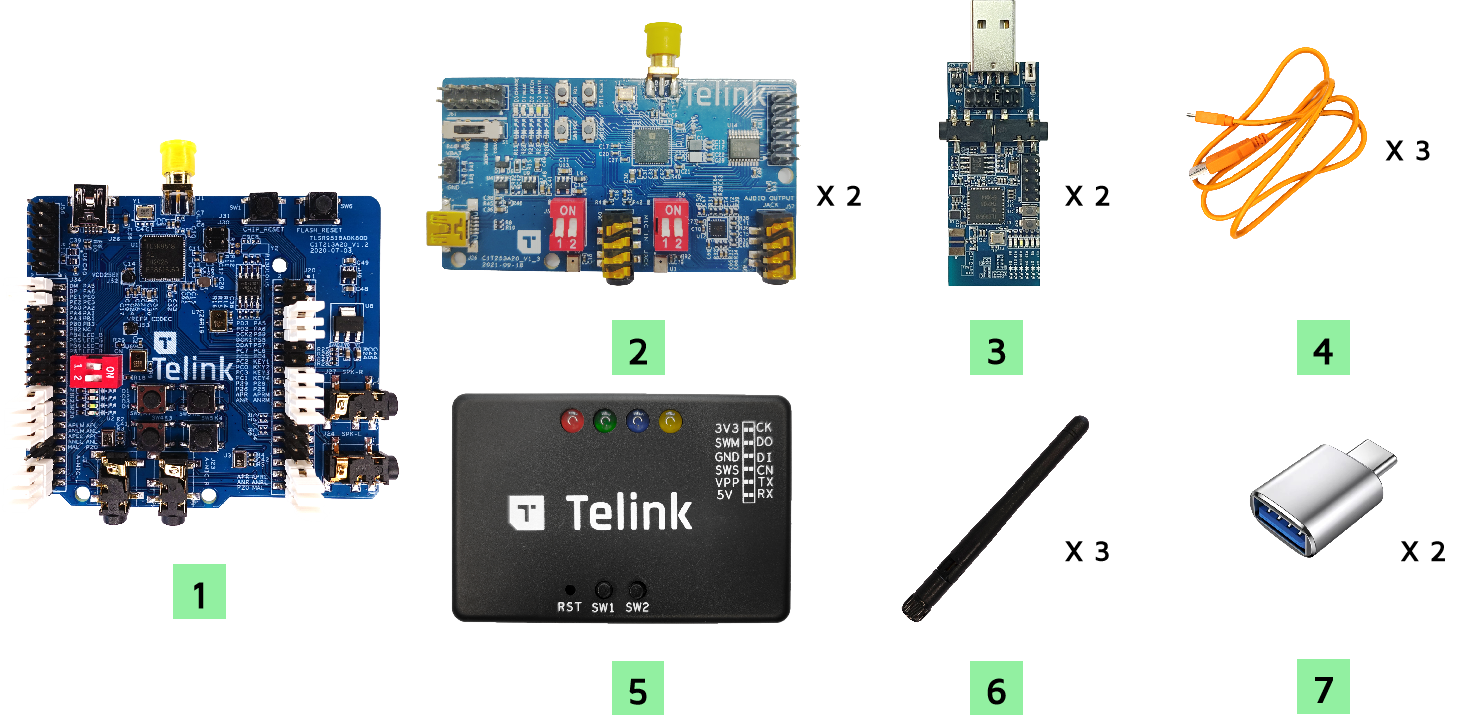
| Item | S/N | Product Name | Qty | Description |
|---|---|---|---|---|
| 1 | TLSR9518ADK80D | B91 Development Board | 1 | including jumpers |
| 2 | TLSR9517CDK56D | B91 Audio Development Board | 2 | including jumpers |
| 3 | TLSR9518ADG80D | B91 Dongle | 2 | |
| 4 | USB cable | 3 | USB A to mini USB | |
| 5 | TLSRGSOCBK56B | Telink Burning Board | 1 | including DuPont wires |
| 6 | Whip Antenna | 3 | 2.4Ghz antenna | |
| 7 | USB Convertor | 2 |
Broadcast Demo Scenario 1

There are N sources broadcasting BIG information in the air. Source 1 has one BIS (Broadcast Isochronous Stream) that transmits two audio channels; source 2 has two BIS, each transmitting one audio channel; and source N has one BIS that only transmits one audio channel.
There is an asynchronous connection between broadcast assistant and broadcast sink, and assistant selects which source to synchronize for the sink through the asynchronous connection. In this scenario, the assistant provides the USB-CDC interface for configuration instructions.
Step 1: Burn broadcast source firmware into two B91 dongle and connect to the phone or PC via USB.
Step 2: Burn the broadcast assistant firmware into a B91 development board and connect it to the PC via USB-CDC.
Step 3: Burn the broadcast sink firmware into a B91 audio development board, power it via USB.
Step 4: Follow the assistant’s operation steps for pairing and connecting, broadcast synchronization, and volume adjustment.
Step 5: Music is played on the phone or PC, and the sink can hear the music being played.
Broadcast Demo Scenario 2
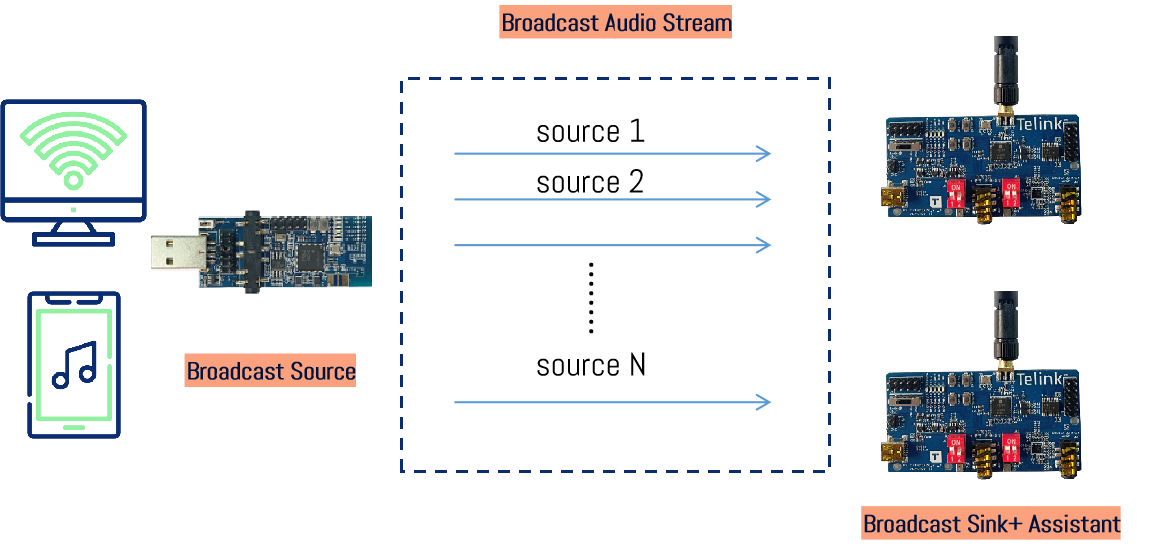
The scenario integrates the sink and assistant functions in one demo, and the user can select to synchronize the source information directly through the buttons on the B91 audio development board.
As a broadcast source, the B91 dongle broadcasts BIG audio to the air. There are N sources broadcasting BIG information in the air. Source 1 has one BIS that transmits two audio channels; source 2 has two BIS, each transmitting one audio channel; and source N has one BIS that only transmits one audio channel.
Broadcast assistant and broadcast sink are integrated in the B91 audio development board. When powered on, it will automatically scan the corresponding broadcast source information in the air, and the assistant UI is simplified to using buttons to trigger synchronization of the new source.
Step 1: Burn broadcast source firmware into two B91 dongle and connect to the phone or PC via USB.
Step 2: Burn the broadcast sink+assistant firmware into a B91 audio board, power it via USB.
Step 3: After pressing the button on the B91 audio board, both SW9 and SW8 can synchronize to the new source information. If there is only one source in the air, the source is repeatedly synchronized.
Step 4: Music is played on the phone or PC, and the sink can hear the music being played.
Broadcast Demo Scenario 3
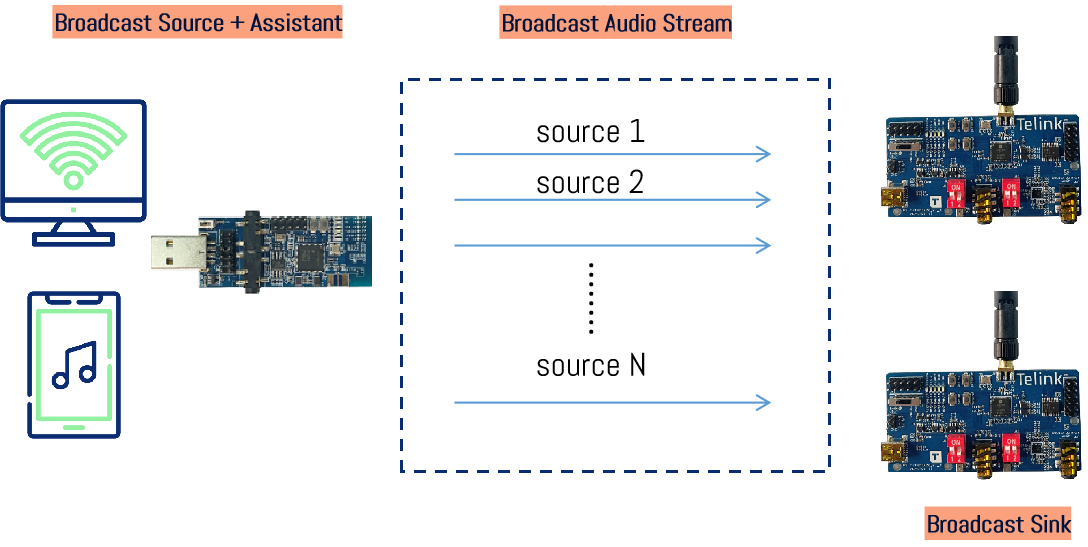
The scenario integrates the source and assistant functions in one demo, and the user can choose which sink device to synchronize the audio through the UART interface.
The B91 dongle acts as a collection of broadcast source+assistant, broadcasts BIG audio to the air. There are N sources broadcasting BIG information in the air. Source 1 has one BIS that transmits two audio channels; source 2 has two BIS, each transmitting one audio channel; and source N has one BIS that only transmits one audio channel.
There is an asynchronous connection between broadcast assistant and broadcast sink, and assistant selects which source to synchronize for the sink through the asynchronous connection. In this scenario, the assistant provides the UART interface to configure instructions.
Purchase
* The development kits can be purchased online via Taobao.